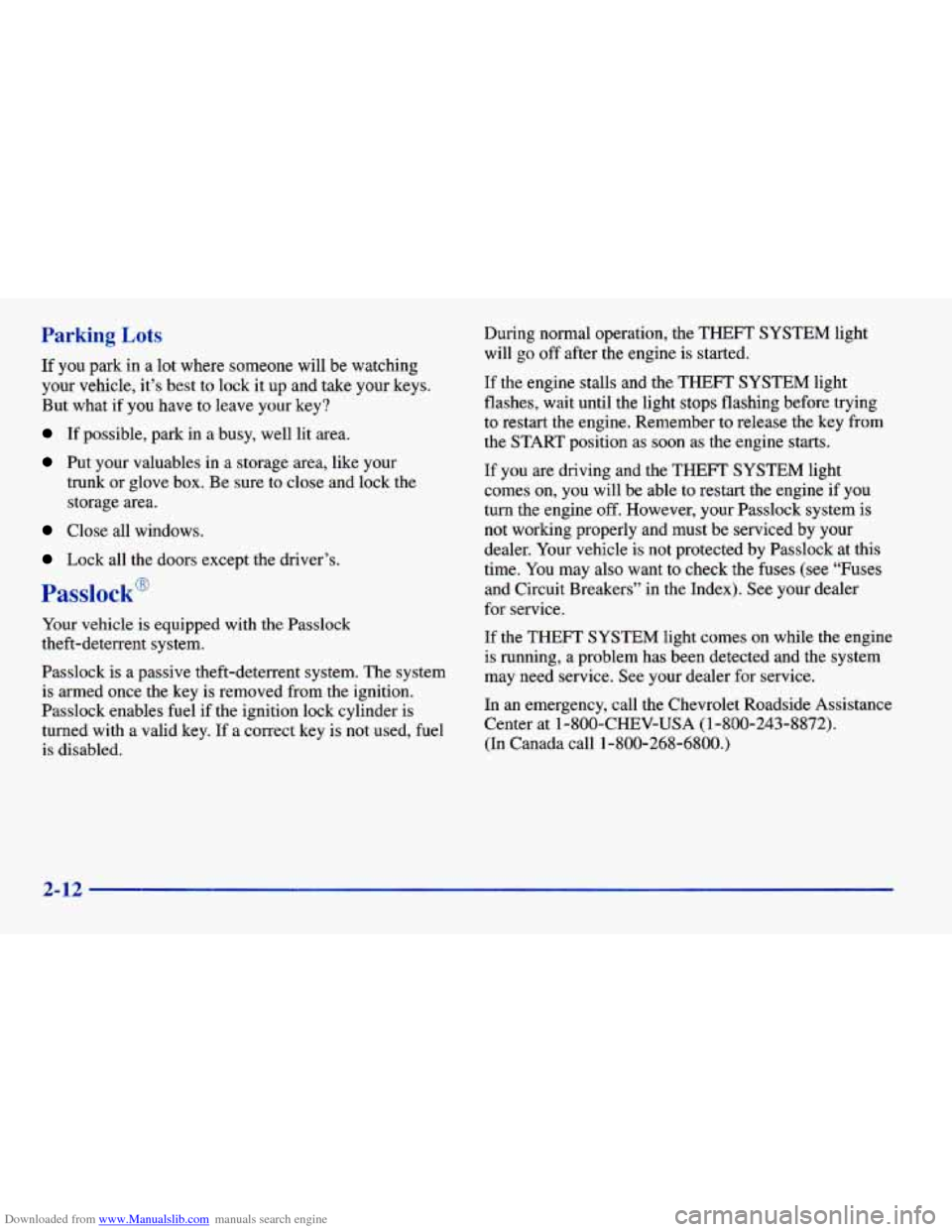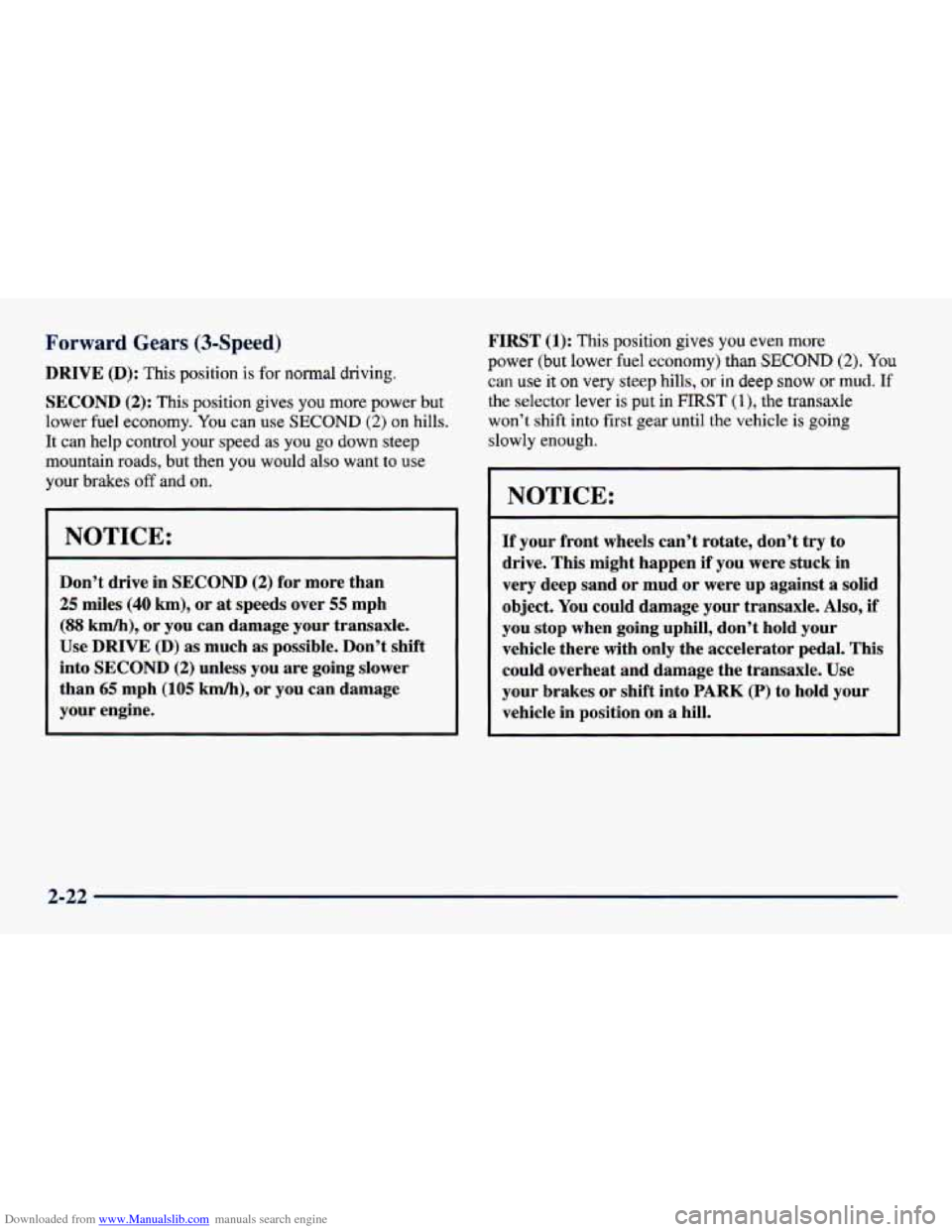Page 8 of 400
Downloaded from www.Manualslib.com manuals search engine Fuse
TRN-BL
F/P-INJ
RR
DFOG
CLUSTER
I TRN-BIL~ ERLS 1 ALA;' PCMIIGN I IGN 1
FIP- INJ AIR BAG CRUISE
RR DFOG PWR ACC STOP HA L HDLP R HDLP
CLUSTER EXT LAMP INT LAMP
HORN
I I I INST LPS I I I
I I I I
I 02 HTR I HVAC I I I I
1
WIPER RADIO
Usage
Exterior Lamps, Back-up Lamps
Fuel Pump, Fuel Injectors
Rear Window Defogger
Instrument Cluster, Anti-Lock
Brake System
Fuse
CLS/PCM
02 HTR
WIPER
ERLS
AIR BAG
PWR ACC
EXT LAMP
HVAC
Usage
Instrument Cluster, Powertrain
Control Module, Daytime
Running Lamps
Rear
02 Sensor Heater
Windshield Wipers,
Windshield Washers
Automatic Transaxle, Brake
Transaxle Shift Interlock, A/C
Compressor, Cruise Control,
Multiport Fuel Injection
Supplemental Inflatable
Restraint System
Power Door Locks, Convertible
Top (Convertible Model Only)
Exterior Lamps, Instrument
Panel Lights
Heater and NC Control, Engine
Cooling
Fan
Page 18 of 400
Downloaded from www.Manualslib.com manuals search engine Vehicle Symbols
These are some of the symbols you may find on your vehicle.
For example,
these symbols are used on an
original battery:
POSSIBLE A
CAUTION
INJURY
PROTECT EYES BY
SHIELDING
CAUSTIC
ACID COULD BAlTERY
CAUSE
BURNS
AVOID
SPARKS OR FLAMES
SPARK
OR ,111,
COULD FLAME
EXPLODE BAITERY
These symbols
are important
for you and
your passengers whenever your
vehicle is
driven:
DOOR LOCK
UNLOCK
n
WINDOW ISJ
These symbols
have to do with
your lamps:
RUNNING 0
DAYTIME -0 0
LAMPS '**
FOG LAMPS $0
These symbols
are on some of
your controls:
WINDSHIELD
DEFROSTER
WINDOW
DEFOGGER
VENTILATING FAN
These symbols
are used on
warning and
indicator lights:
CHARGING BAllERY
SYSTEM
BRAKE
(a)
COOLANT a
ENGINE OIL
PRESSURE
ANTI-LOCK
(a)
BRAKES
Here are some
other symbols
you may see:
FUSE
LIGHTER
n
HORN )tr
SPEAKER
b
FUEL p3
1
viii
Page 88 of 400

Downloaded from www.Manualslib.com manuals search engine Parking Lots
If you park in a lot where someone will be watching
your vehicle, it’s best to lock it up and take your keys.
But what if
you have to leave your key?
If possible, park in a busy, well lit area.
Put your valuables in a storage area, like your
trunk
or glove box. Be sure to close and lock the
storage area.
Close all windows.
Lock all the doors except the driver’s.
Passlock‘
During normal operation, the THEFT SYSTEM light
will go off after the engine is started.
If the engine stalls and the THEFT SYSTEM light
flashes, wait until
the light stops flashing before trying
to restart the engine. Remember to release the key from
the START position as soon as the engine starts.
Your vehicle
is equipped with the Passlock
theft-deterrent system.
Passlock is a passive theft-deterrent system. The system is armed once the key is removed from the ignition.
Passlock enables fuel if the ignition lock cylinder
is
turned with a valid key. If a correct key is not used, fuel
is disabled. If you
are driving and the THEFT SYSTEM light
comes on, you will be able to restart the engine if you
turn the engine off. However, your Passlock system is
not working properly and must be serviced
by your
dealer. Your vehicle
is not protected by Passlock at this
time. You may also want to check the fuses (see “Fuses
and Circuit Breakers” in the Index). See your dealer
for service.
If the THEFT SYSTEM light comes on while the engine
is running, a problem has been detected and the system
may need service. See your dealer for service.
In an emergency, call the Chevrolet Roadside Assistance
Center at 1-800-CHEV-USA
(1-800-243-8872).
(In Canada call 1-800-268-6800.)
2- 12
Page 94 of 400
Downloaded from www.Manualslib.com manuals search engine Engine Coolant Heater (If Equipped)
2.4L Engine
2.2L Engine
In very cold weather, 0 OF (- 18 O C) or colder, the engine
coolant heater can help. You’ll get easier starting and
better fuel economy during engine warm-up. Usually,
the coolant heater should be plugged in a minimum of
four hours prior to starting your vehicle.
2-18
Page 98 of 400

Downloaded from www.Manualslib.com manuals search engine Forward Gears (3-Speed)
DRIVE (D): This position is for normal driving.
SECOND (2): This position gives you more power but
lower fuel economy.
You can use SECOND (2) on hills.
It can help control your speed as you go down steep
mountain roads, but then you would also want to use
your brakes
off and on.
NOTICE:
I
Don’t drive in SECOND (2) for more than
25 miles (40 km), or at speeds over 55 mph
(88 km/h), or you can damage your transaxle.
Use DRIVE
@) as much as possible. Don’t shift
into SECOND
(2) unless you are going slower
than
65 mph (105 km/h), or you can damage
your engine.
FIRST (1): This position gives you even more
power (but lower fuel economy) than SECOND (2). You
can use it on very steep hills, or in deep snow or mud. If
the selector lever is put in FIRST (l), the transaxle
won’t shift into first gear until the vehicle is going
slowly enough.
NOTICE:
-
If your front wheels can’t rotate, don’t try to
drive. This might happen
if you were stuck in
very deep sand or mud or were up against a solid
object. You could damage your transaxle. Also,
if
you stop when going uphill, don’t hold your
vehicle there with only the accelerator pedal. This
could overheat and damage the transaxle. Use
your brakes or shift into
PARK (P) to hold your
vehicle in position on
a hill.
2-22
Page 99 of 400

Downloaded from www.Manualslib.com manuals search engine Forward Gears ($-Speed)
AUTOMATIC OVERDRIVE (D): This position is for
normal driving with the four-speed automatic transaxle.
If you need more power for passing, and you’re:
Going less than about 35 mph (55 km/h), push your
accelerator pedal about halfway down.
Going about 35 mph (55 km/h), push your
accelerator all the way down.
THIRD (3): This position is also used for normal
driving, however, it offers more power and lower fuel
economy than AUTOMATIC OVERDRIVE
(D). Here
are some times you might choose THIRD (3) instead of
AUTOMATIC
OVERDRIVE (D):
0 When driving on hilly, winding roads.
When going down a steep hill.
SECOND (2): This position gives you more power but
lower fuel economy. You can use
SECOND (2) on hills.
It can help control your speed as you
go down steep
mountain roads, but then you would also want to use
your brakes
off and on.
NOTICE:
Don’t drive in SECOND (2) for more than
25 miles (40 km), or at speeds over 55 mph
(90 km/h), or you can damage your transaxle.
Use AUTOMATIC OVERDRIVE (D) or
THIRD
(3) as much as possible. Don’t shift into
SECOND
(2) unless you are going slower than
65 mph (105 km/h), or you can damape
your engine.
2-23
Page 100 of 400
Downloaded from www.Manualslib.com manuals search engine FIRST (1): This position gives you even more
power
(but lower fuel economy) than SECOND (2). You
can use it on very steep hills, or in deep snow or mud. If
the selector lever is put in FIRST (l), the transaxle
won’t shift into first gear until the vehicle is going
slowly enough.
NOTICE:
If your front wheels can’t rotate, don’t try to
drive. This might happen
if you were stuck in
very deep sand or mud or were up against
a solid
object. You could damage your transaxle.
Also, if
you stop when going uphill, don’t hold your
vehicle there with only the accelerator pedal. This
could overheat and damage the transaxle. Use
your brakes or shift into
PARK (P) to hold your
vehicle in position on a hill.
Manual Transaxle Operation
I
This is your shift pattern.
1 3 5
2 4 R
Page 102 of 400
Downloaded from www.Manualslib.com manuals search engine Up Shift Light (Manual Transaxle)
I SHIFT 1
If you have a manual
transaxle, you
have an
SHIFT light. This light
will show you when to shift
to the next higher gear for
the best fuel economy.
When this light comes on, you can shift to the next
higher gear if weather, road and traffic conditions let
you. For the best fuel economy, accelerate slowly and
shift when the light comes on.
While you accelerate, it i! ~ ormal for the light to
go
on and off if you quickly change the position
of the accelerator. Ignore the SHIFT light when
you downshift.
Parking Brake
The parking brake lever is located between the
bucket seats.